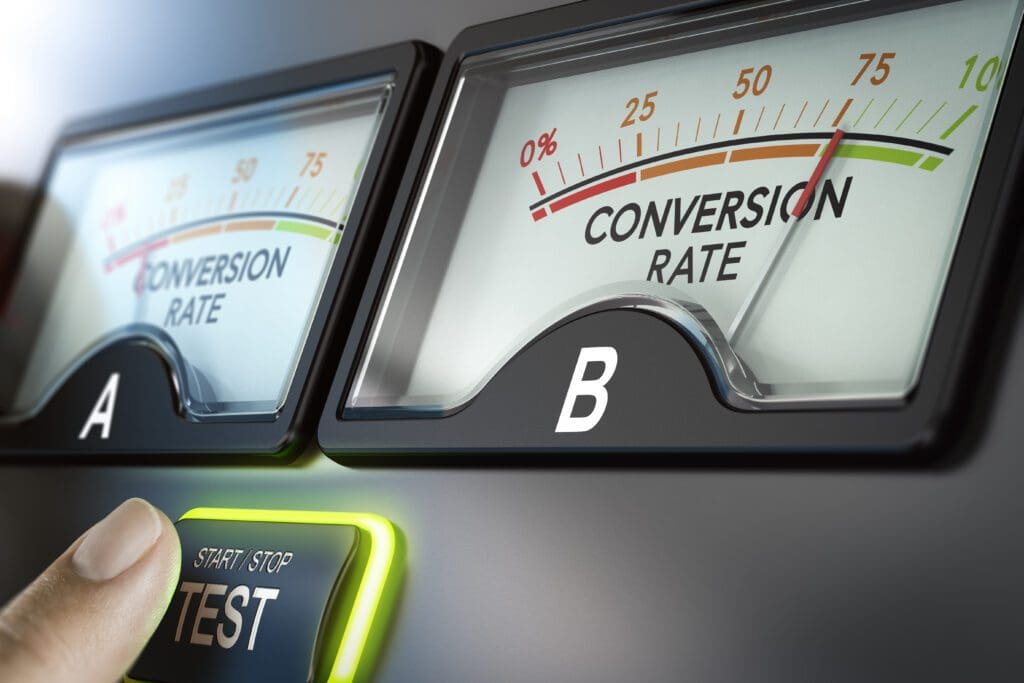A/B testing (also known as split testing) is a proven technique for optimizing websites, landing pages, and offers. This type of testing ensures that they are engaging, converting, and profitable.
And A/B test is a simple way to test two options against one another to determine which one delivers better results.’
And it doesn’t need to be intimidating. Or hard. Or confusing.
We all want to make more money with our websites. But how? We have to maximize and optimize. And that starts with testing and tracking.
It works like this…
At the most basic level, you show someone two options at random and ask them to choose which they prefer. These options are (creatively) called option A and option B. This is where the name A/B test comes from.
Sometimes these tests have more than two options. In this case, you’ll sometimes see it called A/B/n testing, where n means there are many (more than two) variations.
This is useful in online marketing when building and scaling your business.
In this guide, I will teach you everything you need to know about A/B testing. We’ll start with answering simple questions, like “What is an A/B test?” Then we’ll go over the what, where, why, and how of using it in your business for max impact.
You Know Your Customer, But Do You Know How They Are Going to Behave?
A marketer may think that they understand their customers’ needs.
They’ve gone through the customer avatar checklist. Yet, they still run into a few problems…
First, they may be unable to provide the products or services that meet those needs.
Second, they may not be able to explain the way they solve the customer’s problems in a persuasive way.
Or at a price they are willing to pay.
As a result, they may not be able to get the potential customer to take action. This can lead to massive frustration for both the marketer and the customer.
A/B testing solves these problems (and a lot more!).
Consumer behavior – especially online – is often different than what we expect. That’s why split testing is essential for budding neuromarketing efforts.
Consumers often don’t know why they make the decisions and choices they make.
For example, a few months ago, we were at a baseball tournament on the Space Coast of Florida.
We swung into Ron Jon in Cocoa Beach because one of my kids was looking for a pair of sunglasses. While he tried them on and stared in the mirror, preening like the teenager he is, I browsed.
I bought a long sleeve t-shirt from a company named Katin. Now, I’d never heard of the company. I just liked the design. I didn’t need a shirt. And I didn’t go in to buy a shirt. I don’t have a good reason why. I just did. That’s all.
A lot of times, your potential customers are the same way. We may know all the underlying drivers. Their core identity. Their reasons why. But at the end of the day, we may not know exactly how to trigger these things in a practical environment.
A/B Testing Is How You Study Customer Behavior in Real Life
To that end, split testing eliminates all uncertainty associated with optimizing web pages. It offers smart marketers the ability to make data-driven conclusions about consumer behavior.
In A/B testing, we call version A the ‘control.’ It’s the original. The B variation will have a different version of the variable we are testing.
When you split test, you collect data on your primary metric – the marketing KPI you want to improve. With this data, you determine if the B variation is statistically better than the control.
If so, it’s the winner, and it becomes the new control. And then, you repeat the process.
Do this type of testing enough, and you can optimize your site and maximize sales and profits.
What are some marketing KPIs you might seek to improve? For e-commerce and information marketers, conversion rates are always a good start. More advanced marketers might look at average customer value as well. Advertisers might seek to maximize earnings per click. Email marketers will be looking at open and click-through rates. B2B companies might want to maximize qualified leads.
But these are all examples. Any marketing KPI that you can measure, you can optimize through A/B testing.
Split testing helps you gather quantitative insights to verify your qualitative analyses. It helps you understand – and yes, potentially manipulate – consumer behavior. It can help identify core pain points. And help you identify ways to help the customer ease that pain.
If you’re not A/B testing your pages, funnels, and frameworks… you’re leaving a lot of money on the table.
Why A/B Testing is Important
There are many reasons why A/B testing is so important for online marketers. First, it allows you to test different hypotheses about what works and what doesn’t on your site. For example, you might want to know if a certain headline converts better than another. A/B testing lets you do this quickly and easily. And without having to guess or make assumptions about what works best. You run the test, collect the data, and then you know what works… and what doesn’t.
This allows you to fine-tune your marketing campaigns and site design with real data. This is essential in today’s competitive online landscape.
Too often, you feel like you’ve done all the right things. You’ve done your homework and created an ideal customer avatar. You’ve done your “five whys” to understand their deepest motivations. And you’ve honed in on their core identity. You understand your customer.
But you don’t always understand their behavior.
I mean, I love my kids. I’ve walked in their shoes. I understand them and their unique personalities. I know what motivates them.
But sometimes they do things… and I can’t quite understand why they do what they do. How they make the decisions they make. Their behavior isn’t always predictable.
Your customers are the same way. That’s why so many people dismiss customer avatars. They think the exercise is useless because they don’t know how to use it.
A/B Testing Provides Quantitative Measurement of Otherwise Qualitative Behavior
Here’s the dirty little secret. Your customer avatar lays the foundation for analytics and optimization.
It gets you to a place where A/B testing is useful. It turns your customer avatar into full-on neuromarketing. And it helps you understand consumer behavior with concrete data. As a result, you can apply real marketing psychology to your sales frameworks.
A/B testing statistically validates the assumptions inherent in your customer avatar. That’s because A/B experiments are where we put those assumptions to the literal test.
And then, it allows you to optimize the performance of your site for the people you are targeting.
And that, of course, leads to growing and scaling your business.
Create Better Customer Experiences By Eliminating Pain Points Caused by Friction
Your customers are always on a mission. They could be doing general research (problem aware). They could search for information about your company and/or products (solution aware). Or maybe they have their card out ready to buy (product and/or most aware).
And fortunately for us, they face a ton of friction and obstacles. That friction can come in the form of slow websites. Or cumbersome mobile apps. And yes, complicated registration processes. All these can cause pain points that can make customers want to leave your website or app and go somewhere else. But the good news is that you can use A/B testing to end those pain points and improve your customer experience.
No matter their situation, there are several common pain points customers all face. These pain points come from what we call ‘friction.’ We’ve made it too hard to take the next step.
For example, today’s trend is to make beautiful, color-coordinated websites.
So beautiful that the call-to-action button blends right in. And no one sees it. And it never gets clicked. Which causes conversion rates and bank accounts to experience George Costanza-like shrinkage.

No matter how beautiful your page is, if customers don’t get the desired result, it’s a bad user experience.
This friction kills conversion rates.
How do you identify friction points to test? There are more than a few tools out there. Start with qualitative tools such as heat and scroll maps. You’ll see things that users click on (and don’t click on). You’ll see where they stop to read and where they stop scrolling altogether.
This allows you to start coming up with ideas to reduce friction for your ideal customer.
Then you A/B test those ideas one at a time.
Last Updated on October 2, 2022 by Benjamin Teal







